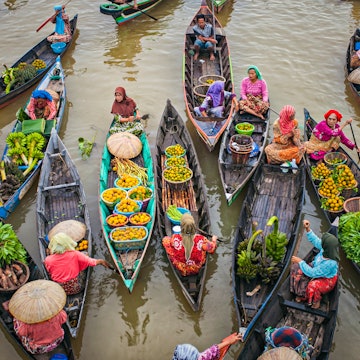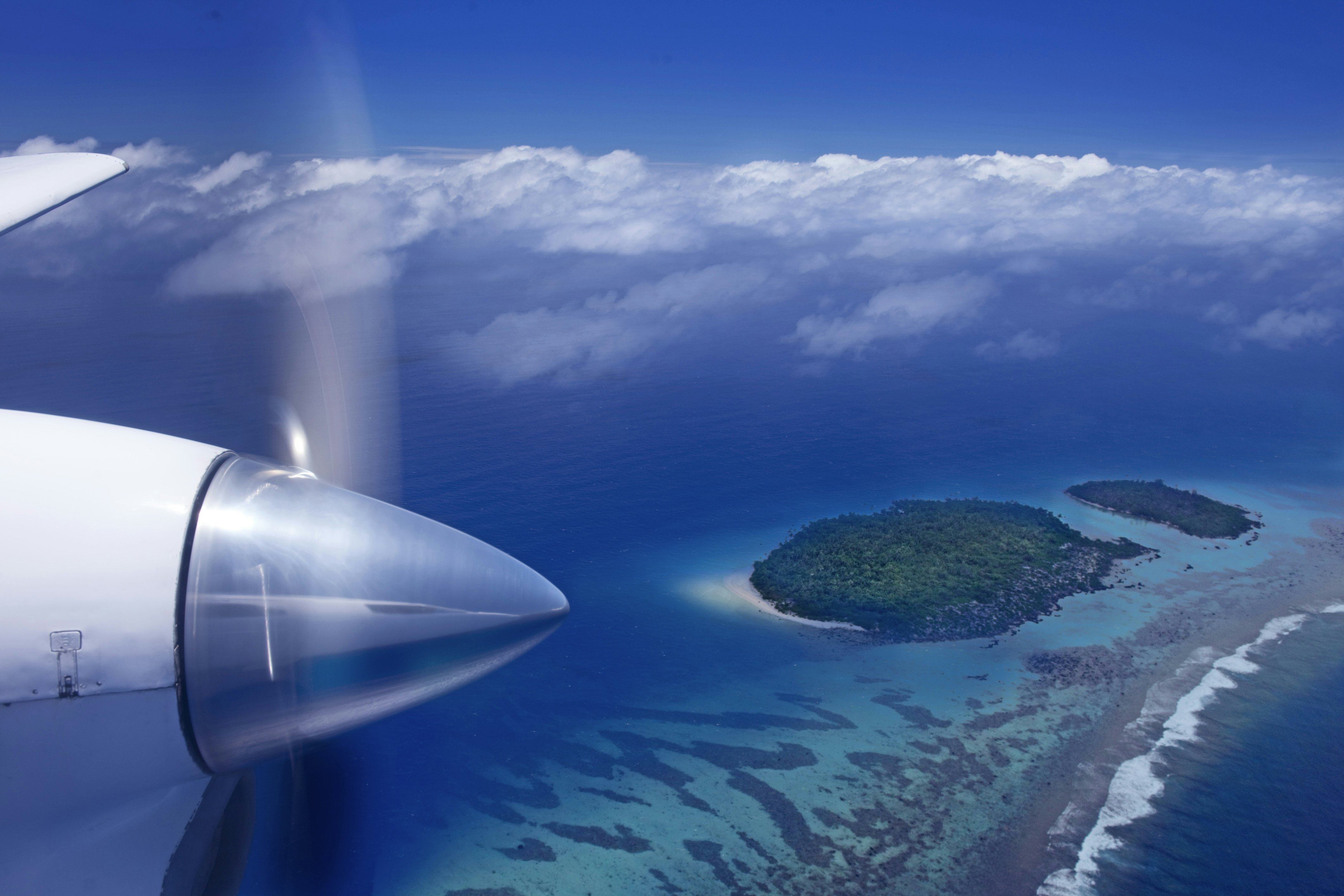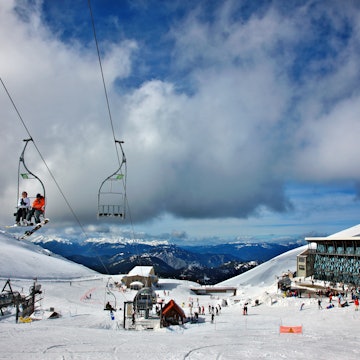
Appreciating the charms of isolation in the Cook Islands
Dec 13, 2021 • 7 min read

Kayaking above the coral atolls is one of the best ways to appreciate the Cook Islands © Helivideo / Getty Images
If you spin a decorative globe to just the right spot, you'll come to a place where there's almost nothing but open blue water. Near the middle of this expansive feature – the Pacific Ocean – you will find the Cook Islands.
Surrounded by nearly 2 million square kilometers of ocean, this tiny nation consists of fifteen small islands formed by ancient volcanoes. The geography here is unique and diverse, ranging from Jurassic Park-like mountains and jungle on Rarotonga, the most populous island, to the fossilized coral cliffs of Mangaia, which is believed to be among the oldest islands in the Pacific.

Farther north towards the equator, you will find low-lying coral atolls – seductive, fascinating landscapes that creep into our dreams, creating a maddening desire to travel there. Due to their remoteness, few of us will ever get there.
Yet somehow, it is here where I found myself at the onset of the pandemic, just as lockdowns were being imposed around the world, and while much of the northern hemisphere was beginning to grapple with the cruelties of winter. Due to travel restrictions, this paradise was nearly devoid of other travelers.
The best time to visit the Cook Islands

Your trip to the islands most likely begins in Rarotonga
I arrived here with my family in early 2020, the final stop in an around-the-world journey. We had wanted to show our daughter the country that my wife and I were lucky to have once called home – a land far removed from the freshwater lakes and deciduous forests of Canada where we were born and raised.
‘Raro’, as it’s called by locals, is fringed with sumptuous, soft coral sand beaches, tall coconut palms and a dramatic mountainous interior. A contrast of verdant greens from the hills and mountains combine with the lagoon’s luxurious shades of blue to make Raro irresistibly Instagrammable.
Prior to the pandemic, visitors could only make their way here from only a handful of gateways – Auckland, Sydney, Los Angeles or French Polynesia. Yet in spite of its isolation, Rarotonga offers flashy holiday villas and a cosmopolitan dining scene devoid of big chains and multinational corporatins. A typical day can include snorkeling in the lagoon, hiking the island’s rugged interior and dinner with top-rated New Zealand wines and freshly caught yellowfin.
I started things off at one of Rarotonga’s cafes with a macchiato. The caffeine was the draw, but it was the conversation that I was really looking for. It is through Cook Islanders that you can peel back the layers of this dynamic region and hear a good yarn about survival and resilience, and what island life is really like.
12 incredible experiences in the Cook Islands

Rarotonga’s picture-perfect Black Rock beach
One morning, under intense sunshine and a warm breeze, I headed to Punanga Nui market, which comes to life every Saturday with sellers offering freshly cooked food, tropical fruits such as passionfruit, papayas and soursop and artisanal goods such as homemade vanilla extract and ukuleles.
I spotted a Cook Islands elder I know and over coffee, he told me his story about growing up in Rarotonga and eventually heading overseas to discover what lies beyond the reef.
The best time to visit the Cook Islands

It’s a journey many have made; there are more Cook Islanders living in New Zealand and Australia than in the Cook Islands itself. Some, like my friend, eventually make it home to retire amongst the plantations and beaches of their birthplace.
I met another young man with a similar history. As we passed away the hours on picture-perfect Black Rock beach on Rarotonga’s north coast, he told me his remarkable story.
His ancestors hailed from the northern atoll of Penrhyn. It’s an island with unique geography – a sliver of land shaped like a giant zero with a massive 233-square-kilometer lagoon in the middle that teems with sharks.
In his late teens, while living in New Zealand, he finally had a chance to visit his ancestral homeland. He traveled to the tiny atoll of Penrhyn from Rarotonga by boat – a 1,400km journey – but on the way back, they were caught in a cyclone. At one point, the boat's passengers were saying their final goodbyes, but after several days the storm subsided, allowing them to dock safely in Rarotonga. He told me he hasn’t returned to Penrhyn since, and if he ever did it would be by airplane – which is challenging in different ways. There are only five permanently habited islands in the far north of the Cook Islands, and only three have airstrips. Commercial flights are irregular and airfare tends to be expensive.

Pukapuka: about as remote as you can get
When my family became stuck in the Cook Islands during the early stages of the pandemic, I found myself in the right place at the right time and was offered a job at the daily newspaper. Several months later, I was given the assignment of a lifetime – a chance to explore and write about the islands of Pukapuka, Manihiki and Penrhyn.
So on a sunny summer morning, I threw my backpack into the back of a small Cessna and off we went, leaving small beautiful Rarotonga in the distance with nothing but blue water ahead of us.
As I stared out the window, I wondered what to expect on this trip. These islands have only a few hundred residents each, and there are no bars, restaurants or cafes. If Rarotonga is considered isolated, these small islands might as well be on a different planet.
After landing in Pukapuka, I immediately felt the remoteness and how limited resources require locals to come up with innovative solutions. The bus that would have normally been used to carry our bags to our accommodation was broken down, so our hosts used a tractor instead. With freshly-husked young coconuts in our hands, we began walking to our water taxi to take us to our accommodation.
South Pacific's most idyllic islands for a tropical getaway

The beauty was striking. Coconut palms leaning over pristine white coral sand beaches, quaint coconut frond cottages along the shore, well-kept taro patches and turquoise waters that couldn’t be more inviting for a leisurely swim. We ate a lunch of fried parrotfish and taro with coconut cream and prepared for our next stop. In less than 24 hours, we were scheduled to fly to our next destination – Manihiki, the island of pearls.

Manihiki and its stunning lagoon
Once the epicenter of the Cook Islands black pearl industry, Manihiki had a slightly more cosmopolitan feel. Many residents I spoke with had traveled abroad at some point in their lives. With similar geography to its neighboring atolls, it has a feature that sets it apart – the small islets in its stunning lagoon.
Many are home to pearl farms called ‘kaoas’, where these prized gems are cultivated. Foreign competition has decimated this once booming industry, leaving many kaoas to fall into disrepair and offering a reminder of how challenging it can be to eke out an existence here.
Nature, however, continues to provide. A dive in the lagoon reveals schools of colorful fish and endless paua (abalone) – some of which will end up in a pot of an irresistible curry.
Residents speak of rehabilitating the kaoas and converting them into lodging for intrepid travelers. I can’t think of a more exclusive Airbnb experience should they fulfill this vision.
The day ends with a dinner of fried fish and an island specialty called poke – a sweet pudding-like treat made with ripe bananas and fresh coconut cream. Apart from our voices, the only sound is the faint thud of waves crashing on Manihiki’s outer reef.

Penrhyn's coconut palms and fresh tuna
We eventually made our way to Penrhyn, the final destination of our trip. It’s a spartan landscape – a lagoon much larger than those at our previous stops, the land not as lush, but still covered with coconut palms and large crabs dashing across the island’s dusty roads.
The next day, we explored the island and talked with locals, meeting a weaver of Penrhyn’s famous hats, trying our luck with some fishing, drinking coconuts and eating copious amounts of fresh, raw tuna.
This was a different type of trip – an embrace of a slower mode of travel. This is perhaps the biggest draw of the Cook Islands: the opportunity to tune out the hysteria and commercialism of our daily lives and indulge in the warmth of good company, good food and natural beauty as far as the eye can see.
You might also like:
How to choose the best island for your Fiji vacation
Natural spoils: why Kiribati is a nature lover's paradise
Why Tanna Island in Vanuatu should be your next big adventure
The Cook Islands are on our 2022 Best in Travel list. For more stories from some of the world’s most exciting destinations click here.
Safety recommendations and restrictions during a pandemic can change rapidly. Lonely Planet recommends that travelers always check with local authorities for up-to-date guidance before traveling during Covid-19.











![Manukau Heads Lighthouse, Auckland, New Zealand [closeup view] License Type: media Download Time: 2022-02-25T15:39:58.000Z User: bhealy950 Is Editorial: No purchase_order:](https://lp-cms-production.imgix.net/2025-10/Shutterstock1352692988.jpg?auto=format,compress&q=72&fit=crop&w=360&ar=1:1)

